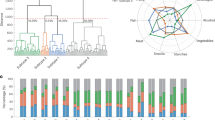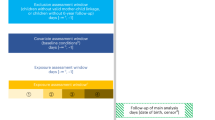Abstract
Background/objectives
To identify the major dietary patterns among preschoolers and assess the relation of major dietary patterns to attention-deficit/hyperactivity disorder (ADHD).
Subjects/methods
A cross-sectional survey was conducted comprising a large sample of 14,912 children aged 3–6 years old in Ma’anshan city of Anhui Province in China. A semi-quantitative food frequency questionnaire and the 10-item Chinese version of the Conners’ abbreviated symptom questionnaire were administered to assess usual dietary intakes and ADHD. Social-demographic information was also collected. Major dietary patterns were identified by principal components analysis. Logistic regression was employed to explore the association of dietary patterns with ADHD.
Results
Five dietary patterns were identified explaining 47.96% of the total diet variation. The “processed” dietary component was the principal pattern that explained the higher percentage of variability, 24.69%. After controlling for potential confounders, preschoolers in the top quintile of the “processed” (odds ratio (OR) = 1.56, 95% confidence interval (CI): 1.31–1.86) and “snack” (OR = 1.76, 95% CI = 1.49–2.07) dietary pattern score had greater odds for having ADHD symptoms compared with those in the lowest quintile. Lowest scores on the “vegetarian” were associated with significantly a higher likelihood of indications of ADHD symptoms (OR = 0.67, 95% CI = 0.56–0.79).
Conclusions
This study showed that preschoolers tend to choose unhealthy dietary pattern in Ma’anshan, China. “Processed” and “snack” dietary patterns were significantly and positively correlated with ADHD symptoms, while “vegetarian” dietary patterns were negatively correlated with ADHD symptoms.
This is a preview of subscription content, access via your institution
Access options
Subscribe to this journal
Receive 12 print issues and online access
$259.00 per year
only $21.58 per issue
Buy this article
- Purchase on Springer Link
- Instant access to full article PDF
Prices may be subject to local taxes which are calculated during checkout
Similar content being viewed by others
References
Rowland AS, Lesesne CA, Abramowitz AJ. The epidemiology of attention-deficit/hyperactivity disorder (ADHD): a public health view. Ment Retard Dev Disabil Res Rev. 2002;8:162–170.
Rowland AS, Skipper BJ, Umbach DM, Rabiner DL, Campbell RA, Naftel AJ, et al. The prevalence of ADHD in a population-based sample. J Atten Disord. 2015;19:741–54.
Willcutt EG. The prevalence of DSM-IV attention-deficit/hyperactivity disorder: a meta-analytic review. Neurotherapeutics. 2012;9:490–9.
Ramtekkar UP, Reiersen AM, Todorov AA, Todd RD. Sex and age differences in attention-deficit/hyperactivity disorder symptoms and diagnoses: implications for DSM-V and ICD-11. J Am Acad Child Adolesc Psychiatry. 2010;49:217–28.
Biederman J. Attention-deficit/hyperactivity disorder: a selective overview. Biol Psychiatry. 2005;57:1215–20.
Froehlich TE, Anixt JS, Loe IM, Chirdkiatgumchai V, Kuan L, Gilman RC. Update on environmental risk factors for attention-deficit/hyperactivity disorder. Curr Psychiatry Rep. 2011;13:333–44.
Millichap JG, Yee MM. The diet factor in attention-deficit/hyperactivity disorder. Pediatrics. 2012;129:330–7.
Woo HD, Kim DW, Hong YS, Kim YM, Seo JH, Choe BM, et al. Dietary patterns in children with attention deficit/hyperactivity disorder (ADHD). Nutrients. 2014;6:1539–53.
Emmett PM, Jones LR, Northstone K. Dietary patterns in the Avon Longitudinal Study of parents and children. Nutr Rev. 2015;73:207–30.
Azadbakht L, Esmaillzadeh A. Dietary patterns and attention deficit hyperactivity disorder among Iranian children. Nutrition. 2012;28:242–9.
Howard AL, Robinson M, Smith GJ, Ambrosini GL, Piek JP, Oddy WH. ADHD is associated with a “Western” dietary pattern in adolescents. J Atten Disord. 2011;15:403–11.
Goyette CH, Conners CK, Ulrich RF. Normative data on revised Conners parent and teacher rating scale. J Abnorm Child Psychol. 1978;6:221–36.
Huang Y, Zheng S, Xu C, Lin K, Wu K, Zheng M, et al. Attention-deficit hyperactivtiy disorder in elementary school students in Shantou, China: prevalence, subtypes, and influencing factors. Neuropsychiatr Dis Treat. 2017;13:785–92.
Chen X, Qian QF. The value of Conners’ abbreviated symptom questionnaire in the diagnosis of attention deficit/hyperactivity disorder. Chin J Child Health Care. 2001;9:201
Manios Y, Kourlaba G, Grammatikaki E, Androutsos O, Ioannou E, Roma-Giannikou E. Comparison of two methods for identifying dietary patterns associated with obesity in preschool children: the GENESIS study. Eur J Clin Nutr. 2010;64:1407–14.
Aranceta J, Pérez-Rodrigo C, Ribas L, Serra-Majem L. Sociodemographic and lifestyle determinants of food patterns in Spanish children and adolescents: the enKid study. Eur J Clin Nutr. 2003;57:S40–S44.
Leventakou V, Sarri K, Georgiou V, Chatzea V, Frouzi E, Kastelianou A, et al. Early life determinants of dietary patterns in preschool children: Rhea mother-child cohort, Crete, Greece. Eur J Clin Nutr. 2016;70:60–65.
Moreira P, Santos S, Padrão P, Cordeiro T, Bessa M, Valente H, et al. Food patterns according to sociodemographics, physical activity, sleeping and obesity in Portuguese children. Int J Environ Res Public Health. 2010;7:1121–38.
Tran DM, Westbrook RF. A high-fat high-sugar diet-induced impairment in place-recognition memory is reversible and training-dependent. Appetite. 2016;110:61–71.
Tran DM, Westbrook RF. Rats fed a diet rich in fats and sugars are impaired in the use of spatial geometry. Psychol Sci. 2015;26:1947–57.
Valladolid-Acebes StucchiP, Cano V, Fernández-Alfonso MS, Merino B, Gil-Ortega M, et al. High-fat diets impair spatial learning in the radial-arm maze in mice. Neurobiol Learn Mem. 2011;95:80–85.
Wiles NJ, Northstone K, Emmett PM, Lewis G. “Junk food” diet and childhood behavioural problems: results from the ALSPAC cohort. Eur J Clin Nutr. 2009;63:491–8.
Schab DW, Trinh NH. Do artificial food colors promote hyperactivity in children with hyperactive syndromes? A meta-analysis of double-blind placebo-controlled trials. J Dev Behav Pediatr. 2004;25:423–34.
Heilskov Rytter MJ, Andersen LB, Houmann T, Bilenberg N, Hvolby A, Mølgaard C, et al. Diet in the treatment of ADHD in children-A systematic review of the literature. Nord J Psychiatry. 2015;69:1–18.
Attuquayefio T, Stevenson RJ, Boakes RA, Oaten MJ, Yeomans MR, Mahmut M, et al. A high-fat high-sugar diet predicts poorer hippocampal-related memory and a reduced ability to suppress wanting under satiety. J Exp Psychol Anim Learn Cogn. 2016;42:415–28.
Ross AP, Darling JN, Parent MB. High energy diets prevent the enhancing effects of emotional arousal on memory. Behav Neurosci. 2013;127:771–9.
Morganstern I, Ye Z, Liang S, Fagan S, Leibowitz SF. Involvement of cholinergic mechanisms in the behavioral effects of dietary fat consumption. Brain Res. 2012;1470:24–34.
Bloch MH, Qawasmi A. Omwf-3 fatty acid supplementation for the treatment of children with attention-deficit/hyperactivity disorder symptomatology:systematic review and meta-analysis. J Am Acad Child Adolesc Psychiatry. 2011;50:991–1000.
Acknowledgements
The authors are extremely grateful to all the colleagues working in the Health Care Department of Maternal and Child Health Centers in Ma'anshan, Department of Maternal and Child Health of Anhui Medical University for the help with data collection; all the teachers who readily helped and consented to carry out the study in the kindergartens; and all the participating caregivers of children. This study was carried out with financial support from the second batch of Anhui provincial health office research projects (grant numbers 13FR006) and the National Natural Science Foundation of China (grant number 81573168).
Author contributions
Study concept and design: FT, SY, and HC. Acquisiton of data: SY, HC, CG, LN, HT, TS, and YX. Analysis and interpretation of data: SY, HC, and FT. Drafting of the manuscript: SY, HC, and FT. Critical revision: SY, HC, CG, LN, HT, TS, YX, and FT.
Author information
Authors and Affiliations
Corresponding author
Ethics declarations
Conflict of interest
The authors declare that they have no conflict of interest.
Ethical approval
Ethical approval was obtained from Biomedicine Ethical Committee in Anhui Medical University.
Additional information
These authors contributed equally: Shuangqin Yan, Hui Cao.
Rights and permissions
About this article
Cite this article
Yan, S., Cao, H., Gu, C. et al. Dietary patterns are associated with attention-deficit/hyperactivity disorder (ADHD) symptoms among preschoolers in mainland China. Eur J Clin Nutr 72, 1517–1523 (2018). https://doi.org/10.1038/s41430-018-0131-0
Received:
Revised:
Accepted:
Published:
Issue Date:
DOI: https://doi.org/10.1038/s41430-018-0131-0
This article is cited by
-
Nutrients patterns and attention deficit hyperactivity disorder among Egyptian children: a sibling and community matched case-control study
European Journal of Clinical Nutrition (2024)
-
Developmental trajectories of hyperactive behavior in children from low-income families: A latent variable growth model analysis
Current Psychology (2024)
-
Nutrition in the Management of ADHD: A Review of Recent Research
Current Nutrition Reports (2023)
-
Development of the Chinese preschooler dietary index: a tool to assess overall diet quality
BMC Public Health (2022)
-
The association between dietary polyphenol intake and attention-deficit hyperactivity disorder: a case-control study
BMC Pediatrics (2022)



